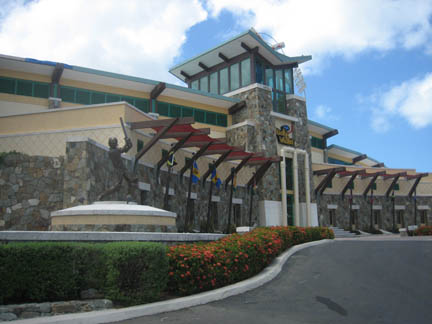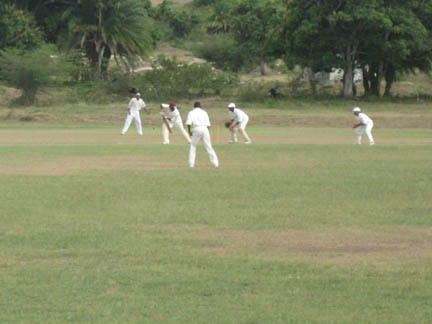
English Harbor, Antigua
Anchored at yellow dot
The same location where Admiral Nelson anchored

Don't be fooled
This is not a news newspaper
My brain has no room for world news

The Sticky Wicket Stadium
Cricket is the pride of the Caribbean
It is their one claim to fame

Sunday afternoon cricket game

Our Lady of Perpetual Help Church
Have you ever heard Garison Kellor
Poke fun at Our Lady of Perpetual Responsibility

Antigua Flag
Barbuda is an island of Antigua
|
Monday, April 10, 2006
We have decided to take the path less traveled to get the north side of Guadeloupe for our sail to Antigua; we will motor through the Riviere Salee. Guadeloupe is comprised of two large land masses, Grande Terre and Bas Terre, which look like the wings of a butterfly. The Riviere Salee is the body of the butterfly. Yes, they call it a river, but it is really a mangrove swamp, cut open and dredged to form a six to nine foot deep canal. The cruising guide recommends thinking of this as an adventure, which it certainly is, rather than a short cut, though it does save about 50 miles of motoring around the island. Our whole trip is an adventure, so why not?
This adventure required that we stage our boat the night before to prepare for a 0500 bridge opening that happens only once a day. You see, there is a four lane freeway that passes over the canal, connecting the butterfly wings. A drawbridge must be raised to allow the tall sailboat masts to pass through, bringing traffic to a standstill. The Guadeloupe commuter is not particularly sympathetic to being delayed for bridge openings for sailboats looking for a shortcut around their island.
It was with great relief that we left the marina. Yes, it is convenient, but the air is heavy, and the water is murky; you might even say putrid. Privacy is non-existent. It’s four in the afternoon and our only goal is to move to the mouth of the Riviere, where we hope to anchor in preparation for tomorrow’s bridge opening. As we work our way up the harbor, past the giant cruise ships, the depth continues to decline, and the safe channel narrows to a few boat widths. The depth sounder reads 5.3 feet, but we don’t seem to be touching bottom. Full Circle draws five feet, five inches. It could be that we are just plowing through a muddy bottom. Anyway, we retreat to a deeper area and anchor for the night.
At 0330, the alarm goes off. It rings a half-hour early, but with our anxiety high, we get up anyway and prepare to weigh anchor. We see the green lights of other boats heading in the direction of the bridge. It is nice to know that we won’t be alone. As we approach the staging area in front of the bridge, we find seven boats. Three catamarans with shallow drafts were able to anchor overnight right in from of the bridge. We are all trying to remain in place, but with the current and tight quarters, we are all jockeying for a comfortable position. At 0505, the bridge begins to open, like two giant jaws preparing to devour us as we pass beneath it. The passage is much narrower, and the current is much faster than we expected. The adventure is for real. Seven boats are trying to arrange themselves in a line, in the dark, in six to seven feet of water. The catamarans glide through first without a problem. Then, the largest of the monohulls, heads for the bridge opening. It is difficult to make out, but we can see people on deck scurrying around with fenders, and then the boat begins to twist as the current pivots the boat and pushes it into the bridge bulkheads. This is not looking good. The boat manages to turn around and work its way back behind the rest of us to prepare for a second pass.
When our turn comes, we are at too sharp an angle, and we find it necessary to throw the engine into reverse before we turn hard to port, raise the rpms to counteract the current, and plow between the concrete bulkheads. It was a tense few moments, but we were through the bridge, and the jaws did not eat us. We zig-zag from red flashing buoy to green flashing buoy as we slither our way up the serpentine canal. The sky is beginning to turn pink, and the mangrove tentacles, which line the edge of the canal, are just becoming visible. The stern light of the boat ahead serves as a helpful guide. By 0630 we are safely through the Rivere Salee, but now we have five more miles of reefs and very shallow water to work our way through. Without a doubt, this was the most complicated navigating we have had to do, and it was not without mishap. We did manage to touch bottom once, but we were able to backup and motor to safe water. It was with great relief that we finally reached the open ocean, put our sails up and headed for English Harbor on the island of Antigua.
English Harbor oozes with history and charm. It was the headquarters of the British Fleet in the Caribbean in the 17th and 18th centuries and has been restored to some of its original splendor. The fortress like stone buildings are currently used to house restaurants, shops, sail makers, bakeries, and other nautical enterprises. You can feel the history around you, and the on-site museum tells the fascinating story when Admiral Nelson was in charge of the British Fleet in the Caribbean. The area is now a national park and named Nelson's Dockyard in honor of the famous admiral who was once stationed here.
Unfortunately, the island of Antigua does not have the same charm as English Harbor. It is not as rustic as Dominica, but it does not compare to the French islands of Martinique or Guadeloupe. Of course, that is not a fair comparison since Martinique and Guadeloupe are part of France, just like Hawaii is a state of the United States.
Of course, we had to rent a car to take a pilgrimage to the Sticky Wicket, the premiere cricket stadium in the Caribbean. The stadium houses a fantastic restaurant and serves as shrine to the past giants of West Indian cricket like Sir Frank Worrell.
While driving to the Sticky Wicket, we passed Our Lady of Perpetual Help Catholic Church. We couldn’t help but think of Our Lady of Perpetual Responsibility immortalized by Garrion Keillor.
Here is an interesting thought from a local pub:
Life is like a bike, you don't fall off until you stop pedaling.
Previous|
Next
|





